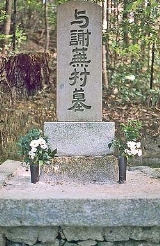
Haiku
Overview
, plural haiku, is a very short form of Japanese poetry
Japanese poetry
Japanese poets first encountered Chinese poetry during the Tang Dynasty. It took them several hundred years to digest the foreign impact, make it a part of their culture and merge it with their literary tradition in their mother tongue, and begin to develop the diversity of their native poetry. For...
typically characterised by three qualities:
- The essence of haiku is "cutting" (kiru). This is often represented by the juxtaposition of two images or ideas and a kirejiKirejiis the term for a special category of words used in certain types of Japanese traditional poetry. It is regarded as a requirement in traditional haiku, as well as in the hokku, or opening verse, of both classical renga and its derivative renku . There is no exact equivalent of kireji in English,...
("cutting word") between them, a kind of verbal punctuation mark which signals the moment of separation and colours the manner in which the juxtaposed elements are related. - Traditional haiku consist of 17 on (also known as moraMora (linguistics)Mora is a unit in phonology that determines syllable weight, which in some languages determines stress or timing. As with many technical linguistic terms, the definition of a mora varies. Perhaps the most succinct working definition was provided by the American linguist James D...
e), in three phrases of 5, 7 and 5 on respectively.

